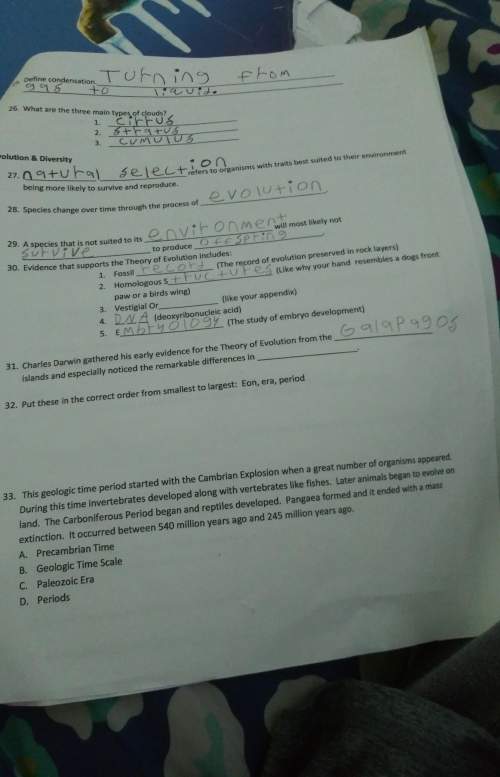
Answers: 2


Another question on Physics

Physics, 21.06.2019 19:30
The lights used by mark watley (played by matt damon) during the film the martian seem to be metal halide lamps. metal halide lamps are filled with vaporized mercury and metal-halogen compounds. when an electric current is passed through the lamp, the tube begins to glow a bright white/blue color. if you were to pass this light through a prism to separate the individual light frequencies, you would see a rainbow just as you would if using natural sunlight because of the complexity of the metal halide gas and the vast amount of possible electron transitions. (the study of light in this way is known as spectroscopy and allows astronomers to know exactly what atoms compose distant stars, simply by looking at the light they emit. the spectral lines an atom produces uniquely identifies that atom just like a fingerprint uniquely identifies a person. the momentum equation and energy equation that we have used above can be combined to give the following equation: c = e p where again p is the phonon momentum, e is the photon energy and c is the speed of light. when you divide the photon energy found in #6 by the photon momentum found in #4, do you get the speed of light? (if not, check your work for questions #4 through #6). yes no
Answers: 2

Physics, 21.06.2019 22:30
Follow these directions and answer the questions. 1. shine a pencil-thin beam of light on a mirror perpendicular to its surface. (if you don't have a laser light as suggested in the video, you can make a narrow beam from a flashlight by making a cone from black construction paper and taping it over the face of the flashlight.) how does the light reflect? how does the relationship of incident to reflected ray relate to the reflection of water waves moving perpendicular to a barrier? 2. shine a pencil-thin beam of light on a mirror standing on a sheet of paper on the table (or floor) so that you can mark the incident ray and reflected ray. (you can support the mirror from the back by taping it to a wooden block.) 3. mark a line on the paper representing the reflective surface. (the reflective surface of a mirror is usually the back edge.) 4. draw a dashed line perpendicular to the mirror surface at a point where the incident and reflected ray meet. this perpendicular is called a normal to the surface. 5. measure the angles between the rays and the normal. the angle of incidence is the angle formed by the incident ray and the normal to the surface. the angle formed by the reflected ray and normal is called the angle of reflection (r). what is the angle of incidence? what is the angle of reflection? 6. repeat for several different angles. (see report sheet for details.) what appears to be the relationship between the angle of incidence and angle of reflection? in science 1204, what was the relationship for these two angles made by the reflection of waves in a ripple tank? 7. roll a ball bearing so that it hits a fixed, hard surface (a metal plate) at several angles (including head-on). observe the way in which the ball bearing reflects. what generalization can you make about how a ball bearing reflects from a wall? have you proved that light can only behave like a wave?
Answers: 1

Physics, 22.06.2019 10:30
What are two different ways you could find the value of a? explain these methods.
Answers: 2

Physics, 23.06.2019 02:50
You are your friend move a new refrigerator into his kitchen. you apply a horizontal force of 252 n in the negative x direction to try and move the 56 kg refrigerator. the coefficient of static friction is 0.61. (a) how much static frictional force does the floor exert on the refrigerator? give both magnitude (in n) and direction. magnitude n direction (b) what maximum force (in n) do you need to apply before the refrigerator starts to move?
Answers: 1
You know the right answer?
What is the state of matter with definite volume?...
Questions

Mathematics, 23.11.2020 23:00

Mathematics, 23.11.2020 23:00

Mathematics, 23.11.2020 23:00

Health, 23.11.2020 23:00

Mathematics, 23.11.2020 23:00

Biology, 23.11.2020 23:00

Mathematics, 23.11.2020 23:00




Physics, 23.11.2020 23:00

Mathematics, 23.11.2020 23:00

Mathematics, 23.11.2020 23:00

Mathematics, 23.11.2020 23:00

History, 23.11.2020 23:00




Mathematics, 23.11.2020 23:00

History, 23.11.2020 23:00




